#st bernard parish
Text
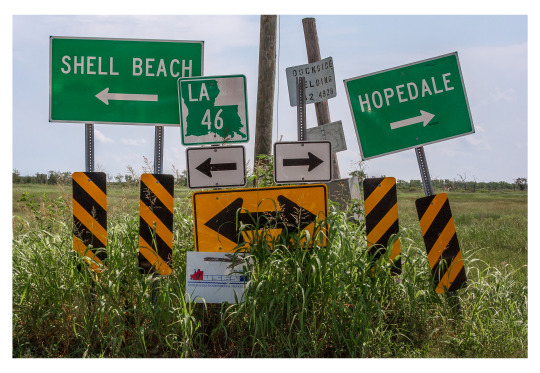

St. Bernard Parish, LA 6/10
#saint bernard#louisiana#photography#photographers on tumblr#landscape#abandoned places#signage#alone#shell beach#st bernard parish
141 notes
·
View notes
Text




Virginia Hanusik
#virginia hanusik#louisiana#south louisiana#architecture#fort proctor#st. bernard's parish#photography
8 notes
·
View notes
Text
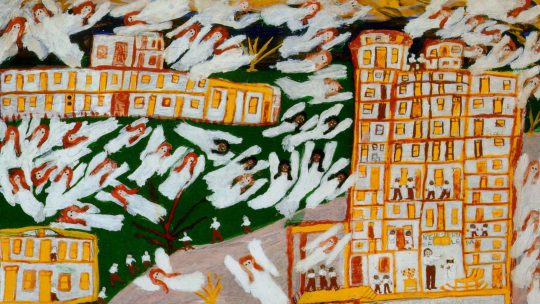
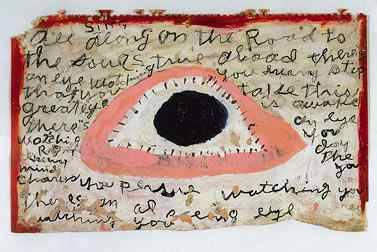

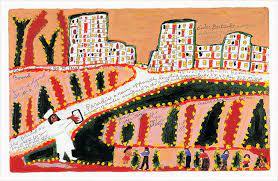
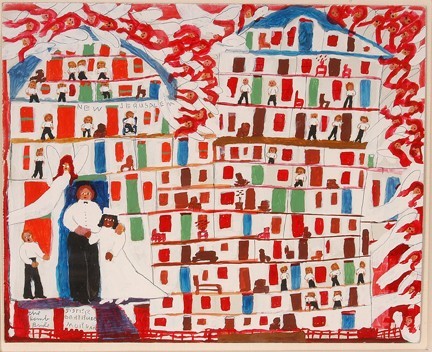



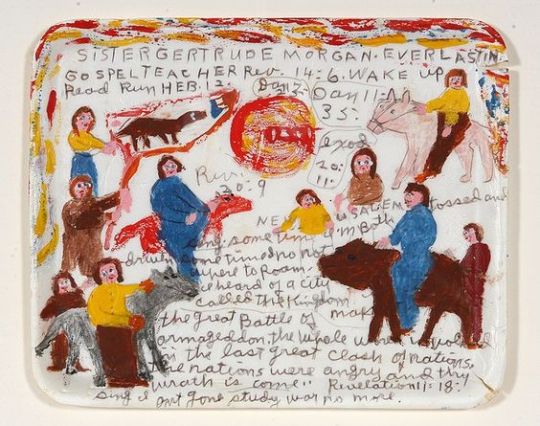

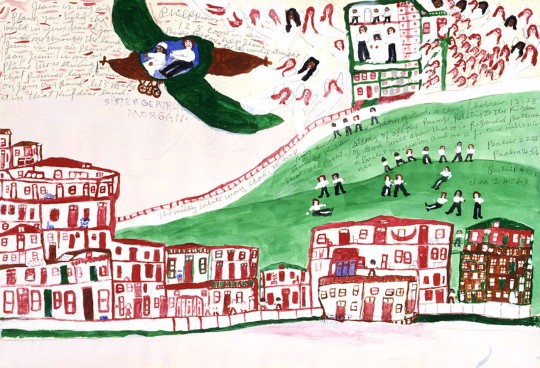
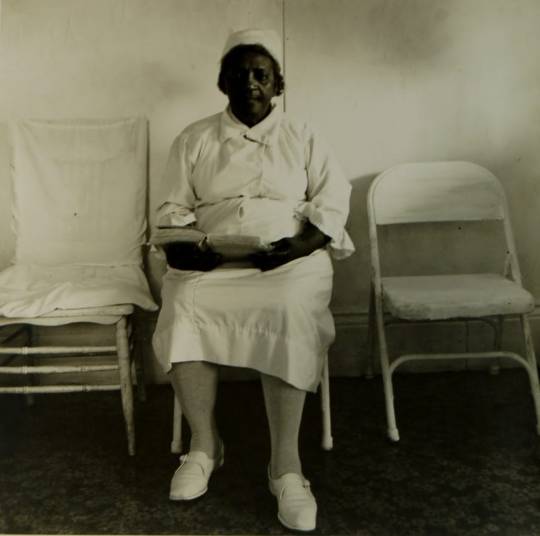
SISTER GERTRUDE MORGAN, 1900 - 1980, born in Alabama, USA.
“I guess my paintings spread the word; they represent something. They get me a living, of course, and help out the mission here … I am a missionary of Christ before I’m an artist. Give all the fame to some other artist. I work for the Lord. Now don’t forget to give Him credit.”
A street preacher who became an artist, poet, and musician, Sister Gertrude Morgan was guided throughout her life by visions from God. Her artistic talent was a conduit to express her religious fervor and illustrate her teachings. Self-taught, Morgan created artworks when the Spirit moved her, using found materials such as cardboard, window shades, wood, signs, and more. Her imaginative compositions often incorporated text to emphasize important themes or to cite Scripture verses. Later in her career after 1970, Morgan devoted the majority of her paintings to biblical scenes from the Book of Revelation, which focuses on the second coming of Christ. Her recurring imagery depicts the Book of Revelation’s theme of the New Jerusalem, which represents the Holy City for Christ’s followers and the fulfillment of all God’s promises. Morgan’s interpretations of this abstract, spiritual concept often include a large multistory building shown in cross section to reveal empty chambers and Christ preparing for His marriage to Sister Gertrude, as shown in New Jerusalem Court and Untitled (New Jerusalem). “And I saw the holy city, new Jerusalem, coming down out of heaven from God, made ready as a bride adorned for her husband.”
Born on April 7, 1900, to a poor rural family in LaFayette, Morgan moved to New Orleans in 1939 to begin her missionary work as a singing street preacher and soon joined the Holiness and Sanctified denomination, a church where the services praised God through music and dancing. In the early 1940s, Morgan adopted the title “Sister” when she worked with two other street missionaries, Mother Margaret Parker and Sister Cora Williams. The three women built a chapel and opened a children’s shelter; the center closed down when it was destroyed by a hurricane in 1965. Morgan then moved to St. Bernard Parish where she became a nurse to a woman whose house later became Morgan’s Everlasting Gospel Mission.
– Vicki Phung Smith
https://www.juxtapoz.com/.../outsider-artist-gertrude.../
https://www.bridgeprojects.com/art.../sister-gertrude-morgan
160 notes
·
View notes
Photo
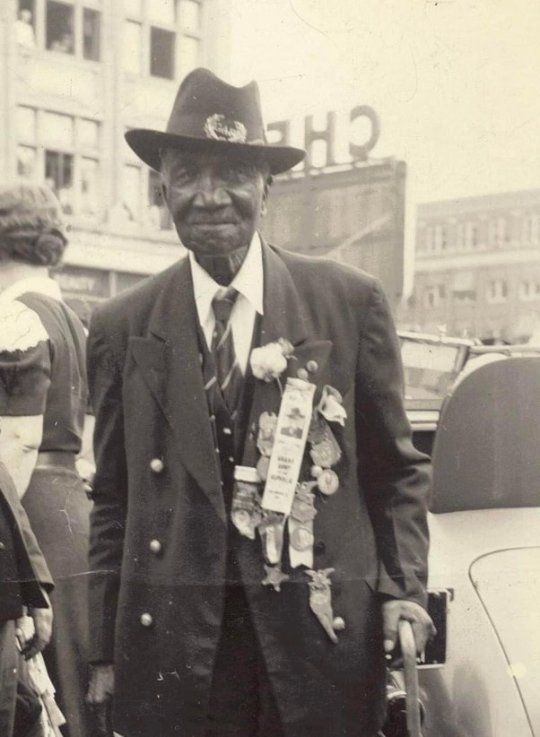
Joseph “Uncle Joe” Clovese was the last known surviving African soldier of the Union Army in the American Civil War, and lived in Pontiac at the time of his death in 1951. Clovese, who lived to be 107 years old, was born into slavery on a plantation in St. Bernard Parish, Louisiana, and escaped slavery in his teens to join the Union Army during the Siege of Vicksburg. He stayed with the Northern Army, first as a drummer, later as an infantryman. He was a private in Co. "C", 63rd Colored Infantry Regiment.
Following the war he worked on Mississippi river steamboats, and he later worked on the crew stringing the first telegraph wires between New Orleans and Biloxi, Mississippi. At the age of 104, Clovese moved from Louisiana to Pontiac, Michigan to be near family. Once the community learned about “Uncle Joe,” the citizens of Pontiac embraced him. Large gatherings were organized for his 105th, 106th and 107th birthdays on January 30th.
For his funeral, more than 300 people were packed into Newman A.M.E. Church in Pontiac (their former location, in downtown) for the service. Hundreds more gathered at the gravesite in Pontiac’s Perry Mount Park Cemetery. Veterans from the Oakland County Council of Veterans served as pall bearers. A firing party from Selfridge Air Force Base fired the final salute and taps was sounded over the cemetery. Pontiac even named a road in his honor, that ran through the Lakeside Homes complex.
461 notes
·
View notes
Text
The Great Flood of 1924 or 1927?aka, a bored trivia post
s1e05 has become the boogeyman of this fanbase for events that largely occur toward the very end of it, but the flood that leads to claudia’s makeshift burials being exposed is very fascinating in terms of chronology. it speaks to how amc iwtv only slightly shifts around history to situate its immortal characters deeply within the environment of a city thats largely viewed by many, including the source material itself, as an ahistorical pleasure garden with no past or present worth caring about.
from @diasdelfuego’s s1 timeline, we have already seen an example of how the show moves with its environment, altering the release date/place of jelly roll morton’s wolverine blues from 1923 indiana to 1917 new orleans [and it be a record the fictional lestat played a role in creating — lestat aiding in a notorious trickster’s story, one of the most oblique lies on louis’s end to make lestat look more sympathetic or one of the funniest historical movearounds on the showrunners’ end, who knows].
this great flood that brings the living situation in rue royale to a head for claudia is another one of them. when lestat and louis read claudia’s diaries, they discover how shes kept careful record of the people shes buried, killed, and mutilated. they interrogate her to ask where the bodies are, and only toward the end of the confrontation does she reveal where she buried them all.
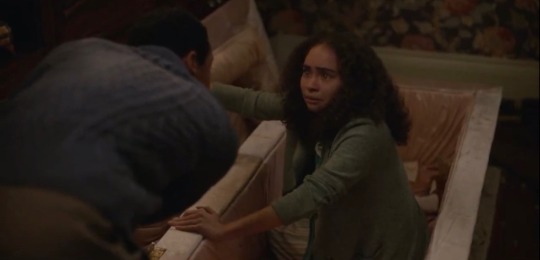

LOUIS: Where are the bodies?
CLAUDIA: Chalmette. Now get out of my room!
LOUIS: Chalmette's three feet below the river line—
CLAUDIA: So what, get out of my room!
LOUIS: What happens when the next storm comes out the Gulf?


and sequenced near immediately, in classic amc iwtv didactic fashion, the next storm comes out the gulf and unburies the bodies claudia buried on very low-lying ground.
now, temporarily exiting the show and into reality, the true flood of southern louisiana in this period occurred in 1927, when the missisippi river valley experienced heavy rainfall.
where disaster stops, and where segregationist city engineers enter, is that bankers and business leaders in new orleans lobbied the governor to intentionally broke the levee outside of new orleans proper, and so he did, ensuring that the city itself would not be flooded, but flooded out much of the low-lying areas in st. bernard parish. remember chalmette? it is in st. bernard parish.
the subsequent conversation lestat + louis have with tom anderson confirm this even more, with tom describing the number of bodies, the 56 ‘floaters’ from the ninth ward [a neighborhood in new orleans that borders chalmette], all people who have been mutilated in some fashion.
tom anderson notes this as well:
Most of the poor fools they hooked out of the bayou are former inhabitants of the Quarter, so don't be too startled if the police come knockin' on your door.
indicating that most of the people claudia killed, mutilated, and buried there were the wealthy, white neighbors of the rue royale mansion and not residents of low-lying parishes that were seen as fodder by the state of louisiana. now why didnt lestat, who was able to hypnotize an entire room of soldiers in episode 3, hypnotize the 3-4 officers that came to inspect their mansion? questions, questions… (that have very obvious answers but are secondary to this post)
referring back to the s1 timeline linked, this great flood of 1927 was either moved up to 1924, matching the decision to move up + alter the creation of the wolverine blues in episode 3 for narrative reasons, and/or refers to the odyssey of recollection, aka., how keeping exact dates and recalling the numerous historical events u have lived under after 145 or so years of misery become difficult. this post is just a fun little trivia bit + something i found to be interesting
81 notes
·
View notes
Text
On September 29th we venerate Ancestor, Voodoo Priestess, & Hoodoo Saint Mama Julia Brown on the 108th anniversary of her passing 🕊
[for our Hoodoos of the Vodou Pantheon]
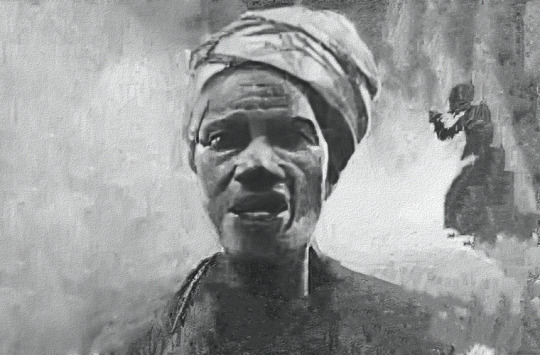
Mama Julia Brown was a Hoodoo woman, healer, & Voodoo Priestess who - on the day of her funeral - took the entire parish of St. John, to her grave.
There was once a very small town called, Frenier, surrounded by Manchac Swamp in St. John's Parish in Acadiana, Lousiana.
Here is where Mama Julia Brown (born Julia Bernard in about 1845) lived on a 40 acre homestead on the edge of the swamp; left to her after her husband's passing in 1914.
It is believed that Mama Julia moved to Frenier from New Orleans where she was already established as a Voodoo Priestess known for her charms and curses.
There were no doctors in Frenier, so Mama Julia served as midwife & traiteur (healer) to the few yet proud locals. Folks went to her often. She was especially known for her singing - what many perceived as - eerie songs with her guitar on her porch.
Overtime, the locals began to take Mama Julia’s services for granted. Soon, they noticed a change in her. For their ungratefulness, she started to scare them by fortelling when terrible things were about to happen to them.
Once she knew that her own life was near its end, Mama Julia spent her last days on her porch steady singing, “One day I’m gonna die, and I’m gonna take all of you with me."
On September 29th 1915 Mama Julia passed away. The townsfolk gathered to lay her to rest. As they placed her casket into the ground, heavy hurricane rains forced them back into their homes. The storm surge rose to 13ft as winds howled at 125 mph. The rain and winds were so powerful that it wiped out the entire town, along with 2 neighboring small towns of Ruddock & Naptown. Roads were flattened. Buildings demolished. And miles of railway tracks were washed away into the swamp. There were no known survivors. The hurricane, it seemed, came out of nowhere.
A newspaper account from 1915 describes Mama Julia Brown's funeral on the day of the storm: “Many pranks were played by wind and tide. Negroes had gathered for miles around to attend the funeral of ‘Aunt’ Julia Brown, an old negress who was well known in that section, and was a big property owner. The funeral was scheduled … and ‘Aunt’ Julia had been placed in her casket and the casket in turn had been placed in the customary wooden box and sealed. At 4 o’clock, however, the storm had become so violent that the negroes left the house in a stampede, abandoning the corpse. The corpse was found Thursday and so was the wooden box, but the casket never has been found.”
Voodoo is, of course, is much more about healing & liberation than curses & crossings. For this reason, there are many in the Community who did not believe that Mama Julia placed any sort of curse on Frenier, despite the reasons she may have had. Instead, some believe that Mama Julia's songs were a warning to the townsfolk of an impending doom. And that she might've done ritual work to prevent the storm from hitting Frenier, but was too late.
“Aunt Julia Brown … always sat on her front porch and played her guitar and sang songs that she would make up. The words to one of the songs she sang said that one day, she would die and everything would die with her.” - personal account of Helen Schlosser Burg; longtime resident of Frenier.
Today Mama Julia rests in perpetual tranquility at the grounds of Frenier, now a mass grave, in Manchac Swamp. Though she become quite the ghost story icon, Mama Julia Brown is most affectionately remembered as a beloved Hoodoo woman; as healer and midwife. That her spirit is less of a thing to fear in the swamp than the gators, snakes, and other predatory creatures that stir.
Offering suggestions: hurricane water, money/coins, swamp soil, play/sing the guitar, & cypress
‼️Note: offering suggestions are just that & strictly for veneration purposes only. Never attempt to conjure up any spirit or entity without proper divination/Mediumship counsel.‼️
#the hoodoo calendar#hoodoos#hoodoo#atr#atrs#Hoodoo women#Hoodoo Folklore#Mama julia brown#Voodoo#Hoodoo History
63 notes
·
View notes
Text
SAINT OF THE DAY (May 28)

The Church remembers St. Bernard of Menthon on May 28.
He was born in 923, probably in the Menthon Castle near Annecy, Savoy. He died in 1008 at Novara.
He was a descendant from a rich, noble family and received a thorough education.
He refused to enter an honorable marriage proposed by his father and decided to devote himself instead to the service of the Church.
Placing himself under the direction of Peter, Archdeacon of Aosta, under whose guidance he rapidly progressed, Bernard was ordained priest.
On account of his learning and virtue, he was made Archdeacon of Aosta in 966, having charge of the government of the diocese under the bishop.
Seeing the ignorance and idolatry still prevailing among the people of the Alps, he resolved to devote himself to their conversion.
For 42 years, he continued to preach the Gospel to these people and carried the light of faith even into many cantons of Lombardy, effecting numerous conversions and working many miracles.
For another reason, however, Bernard's name will forever be famous in history.
Since the most ancient times, there was a path across the Pennine Alps leading from the valley of Aosta to the Swiss canton of Valais, over what is now the pass of the Great St. Bernard.
This pass is covered with perpetual snow from seven to eight feet deep, and drifts sometimes accumulate to the height of forty feet.
Though the pass was extremely dangerous, especially in the springtime on account of avalanches, it was often used by French and German pilgrims on their way to Rome.
For the convenience and protection of travelers, St. Bernard founded a monastery and hospice at the highest point of the pass, 8,000 feet above sea-level in the year 962.
A few years later, he established another hospice on the Little St. Bernard, a mountain of the Graian Alps, 7,076 feet above sea-level.
Both were placed in charge of Augustinian monks after pontifical approval had been obtained by him during a visit to Rome.
These hospices are renowned for the generous hospitality extended to all travelers over the Great and Little St. Bernard, so called in honor of the founder of these charitable institutions.
At all seasons of the year, but especially during heavy snow-storms, the heroic monks accompanied by their well-trained dogs, go out in search of victims who may have succumbed to the severity of the weather.
They offer food, clothing and shelter to the unfortunate travelers and take care of the dead.
They depend on gifts and collections for sustenance.
The majority of these men live at the hospice while some have charge of neighboring parishes.
The last act of St. Bernard's life was the reconciliation of two noblemen whose strife threatened a fatal issue.
He was interred in the cloister of St. Lawrence. Venerated as a saint from the 12th century in many places of Piedmont (Aosta, Novara and Brescia), he was canonized in 1681 by Pope Innocent XI.
He gave his name to the Saint Bernard breed of dogs, originally bred for the cold environment of the hospice.
5 notes
·
View notes
Text
A home away from a homeland
New Post has been published on https://thedigitalinsider.com/a-home-away-from-a-homeland/
A home away from a homeland


When the Haitian Multi-Service Center opened in the Dorchester neighborhood of Boston in 1978, it quickly became a valued resource. Haitian immigrants likened it to Ellis Island, Plymouth Rock, and Haiti’s own Citadel, a prominent fort. The center, originally located in an old Victorian convent house in St. Leo Parish, provided health care, adult education, counseling, immigration and employment services, and more.
Such services require substantial funding. Before long, Boston’s Cardinal Bernard Francis Law merged the Haitian Multi-Service Center into the Greater Boston Catholic Charities network, whose deeper pockets kept the center intact. Law required that Catholic welfare promote the church’s doctrine. Catholic HIV/AIDS prevention programs started emphasizing only abstinence, not contraception. Meanwhile, the center also received state and federal funding that required grantees to promote medical “best practices” that contrasted with church doctrines.
In short, even while the center served as a community beacon, there were tensions around its funding and function — which in turn reflect bigger tensions about our civic fabric.
“These conflicts are about what the role of government is and where the line is, if there is a line, between public and private, and who ultimately is responsible for the health and well-being of individuals, families, and larger populations,” says MIT scholar Erica Caple James, who has long studied nongovernmental programs.
Now James has written a new book on the subject, “Life at the Center: Haitians and Corporate Catholicism in Boston,” published this spring by the University of California Press and offering a meticulous study of the Haitian Multi-Service Center that illuminates several issues at once.
In it, James, the Professor of Medical Anthropology and Urban Studies in MIT’s Department of Urban Studies and Planning, carefully examines the relationship between the Haitian community, the Catholic Church, and the state, analyzing how the church’s “pastoral power” is exercised and to whose benefit. The book also chronicles the work of the center’s staff, revealing how everyday actions are connected to big-picture matters of power and values. And the book explores larger questions about community, belonging, and finding meaning in work and life — things not unique to Boston’s Haitian Americans but made visible in this study.
Who makes the rules?
Trained as a psychiatric anthropologist, James has studied Haiti since the 1990s; her 2010 book “Democratic Insecurities” examined post-trauma aid programs in Haiti. James was asked to join the Haitian Multi-Service Center’s board in 2005, and served until 2010. She developed the new book as a study of a community in which she was participating.
Over several decades, Boston’s Haitian American population has become one of the city’s most significant immigrant communities. Haitians fleeing violence and insecurity often gained a foothold in the city, especially in the Dorchester and Mattapan neighborhoods as well as some suburbs. The Haitian Multi-Service Center became integral to the lives of many people trying to gain stability and prosperity. And, from residential clergy to those in need of emergency shelter, people were always at the site.
As James writes, the center “literally was a home for many stakeholders, and for others, a home away from a homeland left behind.”
Church support for the center worked partly because many Haitians felt aligned with the church, attending services and Catholic schools; in turn the church provided uniquely substantial support for the Haitian American community.
That also meant some high-profile issues were resolved according to church doctrine. For example, the center’s education efforts about HIV/AIDS transmission did not include contraception, due to the church’s emphasis on abstinence — which many workers considered less effective. Some staff members would even step outside the center to distribute condoms to community members, thus not violating policy.
“We started as a grassroots organization. … Now we have a church making decisions for the community,” said the former director of the center’s HIV/AIDS prevention programming. By 1996, the center’s adult literacy staff resigned en masse over policy differences, with some workers asserting in a 1996 memo that the church “has assumed a proprietary role over our work in the Haitian community.”
Coalition, not consensus
Another policy tension surrounding Catholic charities emerged after same-sex marriage became legal in Massachusetts in 2004. In 2005, a reporter revealed that over the previous 18 years the church had facilitated 13 adoptions of difficult-to-place children with gay couples in the state. After this practice became publicized, the church announced in 2006 that its century of adoption work would end, so as to not violate either church or state laws.
Ultimately, James says, “There are structural dimensions that were baked in, which almost inevitably produced tensions at the institutional or organizational level.”
And yet, as James chronicles attentively, there was hardly consensus about the church’s role in the center. The center’s Haitian American community members were a coalition, not a bloc; some welcomed the church’s presence at the center for spiritual or practical reasons, or both.
“Many Haitians felt there was value from [the center] being independent, but there are others who felt it would be difficult to maintain otherwise,” James says.
Some of the community members even expressed lingering respect for Boston’s Cardinal Law, a central figure of the Catholic Church abuse scandal that emerged in 2002; Law had personally championed the charitable work the church had been performing for Haitians in Boston. In this light, another question emerging from the book, James says, is, “What encourages people to remain loyal to an imperfect institution?”
Keepers of the flame
Some of the people most loyal to the Haitian Multi-Service Center were its staff, whose work James carefully details. Some staff had themselves previously benefitted from the center’s services. The institution’s loyal workers, James writes, served as “keepers of the flame,” understanding its history, building community connections, and extending their own identities through good works for others.
For these kinds of institutions, James notes, “They seem most successful when there is transparency, solidarity, a strong sense of purpose. … It [shows] why we do our jobs and what we do to find meaning.”
“Life at the Center” has generated positive feedback from other scholars. As Linda Barnes, a professor at the Boston University School of Medicine, has stated, “One could read ‘Life at the Center’ multiple times and, with each reading, encounter new dimensions. Erica Caple James’s work is exceptional.”
What of the Haitian Multi-Service Center today? In 2006, it was moved and is now housed in Catholic Charities’ Yawkey Center, along with other entities. Some of the workers and community members, James notes in the book, consider the center to have died over the years, compared to its stand-alone self. Others simply consider it transformed. Many have strong feelings, one way or another, about the place that helped orient them as they forged new lives.
As James writes, “It has been difficult to reconcile the intense emotions shared by many of the Center’s stakeholders — confusion, anger, disbelief, and frustration, still expressed with intensity even decades later — alongside reminiscences of love, joy, laughter, and care in rendering service to Haitians and others in need.”
As “Life at the Center” makes clear, that intensity stems from the shared mission many people had, of finding their way in a new and unfamiliar country, in the company of others. And as James writes, in concluding the book, “fulfillment of a mission is never solely about single acts of individuals, but rather the communal striving toward aiding, educating, empowering, and instilling hope in others.”
#Anthropology#board#book#Books and authors#Building#Cambridge#Boston and region#Children#Community#democratic#details#dimensions#education#emotions#emphasis#employment#federal#Funding#Government#Haiti#Health#Health care#History#hiv#HIV/AIDS#how#identities#Immigration#issues#it
3 notes
·
View notes
Note
some pairs: peter/gamora, bucky/sarah, han/leia, aishwarya/vikram
some words: literary, aromatic, windswept, proximity
sarah/bucky, windswept
Two Boots River was not ever a river but in fact a marshy channel that got bogged up by water reeds and slime in the summer season. The residents of St. Bernard’s Parish had called it such before there was a parish for St. Bernard anywhere in sight, and at this point it was a long abandoned fisherman’s route; the overnight shacks lining dotting the route were decrepit and all the best spots for crab traps were infested. No one knew by what, but nobody went there anymore anyway, if they were smart. Unless they were taking a shortcut home, to get back in time for a meeting with a potential investor, which Sarah Wilson had scheduled for tomorrow.
“Fuck,” says the woman in question. “Shit damn. This is what I get for being an idiot.”
She isn’t leaning over the side of the boat because that would be terribly unwise in a gale. It could be a hurricane. Nothing about one in the news, but Sarah wouldn’t bet against that just being her luck.
“Maybe I’ll find those boots,” calls out her companion, over the roaring rainstorm.
“You will not,” Sarah says. She keeps having to swipe water out of her eyes. God, it is terrible out here, and the St. Grace is stuck. She is in one of those positions where she cannot be thankful that they made enough money in the last quarter for her to be able to buy a second boat – not when they could possibly lose it in a freak storm of her own idiocy. “You’ll find a bunch of ghosts, that’s what those boots belong to.”
He eyes the churning muck below them with a detachedly contemplative precision that doesn’t make sense given the hurricane. “It’s not a hurricane,” Bucky says.
“I’m gonna lose my house,” says Sarah, wiping her face again and holding down a rope for dear life, lest the whole thing pick up and fly away. “Please God let my children be in the neighbour’s storm room. You haven’t lived here.”
“I can do ghosts,” he says instead of answering her, and then jumps into the water.
If Sarah were a better person she’d have stopped him, for the sake of his general health. This kind of bog muck in the middle of a storm can kill a person, just as sure as it can get a boat stuck in the middle of fucking nowhere. Sarah throws the line down anyway and swears a bit more to herself because there is no one there but God and the ghosts to hear. After three minutes of the wind’s interminable howling she is sure Bucky Barnes is dead and she has killed him. Then the line goes taut and St. Grace lurches and Sarah nearly falls so hard she breaks her nose.
“Jesus,” she says. They are moving forward, by inches. The braken sludges away around St. Grace’s hull. She’s gonna miss her meeting for sure. “Bucky?” she calls out into the howl of the storm. “James?” They’re moving forward in earnest now. But she can’t really see him. If they’re moving he hasn’t drowned. Sarah is being practical about it.
“James B you better not be dead,” she says.
Bucky pops out of the water about a yard away, black with mud. He’s the wettest equivalent of windswept, like the gale winds were going at him under the water too.
“Fuck,” he says, and spits out muck. The rope is wound tight around his left arm and she can see the strain of exertion in his neck, under the muck. His eyes look frightened by something that is not the storm. Ghosts, probably. The fool. He didn't think, did he. Regardless, Sarah wets her bottom lip, unnecessarily given the storm, and doesn't know why she didn’t fully believe him when he said he'd pull them out by hand. Wildly, for a moment, Sarah wonders: if were her house really to be blown away, could Bucky build her a new one?
But just now his eyes still look frightened -- they are the only part of his face she can really make out -- so she puts that thought out of mind and calls directions out to him over the wind, so they can find safety together.
Blessedly, he hears her.
An hour later they are sheltering in one of those abandoned fisherman’s shacks. Except it’s not abandoned, as there was a can of beans in the pantry and wood for a fire by the stove, also non-moldy blankets closed up in a pretty modern plastic bin.
“I feel like I’m camping,” Sarah says. “Guess I’m not the only person stupid enough to take Two Boots. My meeting …” she sighs, trailing off. She is wrapped in one of the blankets but still has her shorts and t-shirt on, as they didn’t take too much damage under her parka. Bucky’s across from her on the other side of the table, wrapped in the two remaining blankets, which he’s mostly using to cover his left side and damp boxers. They watch his sopping clothes drip slow slow slow onto the floor by the stove fire, together.
“Those are gonna be gross tomorrow,” he says.
“It’s okay,” says Sarah, tired, rubbing one eye and not thinking about it. “I don’t mind you being a little naked.”
She cringes then, because that’s not really fair or appropriate. Bucky came with her because he is technically her employee or something. She’s not sure. Of course he is family, and he isn’t out there superheroing with Sam at present, which he has not called retirement but certainly hasn’t talked much about in a different capacity either. He just showed up one day and Sarah started giving him things to do because Lord knows they needed to be done, and she liked having him around.
She chances a glance at him and he looks mildly amused, save for the traitorous pink flush on his neck, which she figures he can’t help as a white person. Poor thing.
“Sorry,” she says.
“It’s fine,” hasty. “I’m just – the mud brought back bad memories.” She realizes he is trying to apologize for being quiet, which she now realizes could have maybe been read as taciturn or even completely dissociated, but she was so caught in her own worries she really didn’t notice.
“Oh, James,” she says.
“The house will be okay, you know?”
“Will you?”
He grunts. Looks at her a long time. The fire goes on crackling. She looks at the crates in the corner, which hold the engine parts they’d gone to pick up for a little skiff that’ll help St. Grace with the fishing. Sarah is terrible at delegating; someone else could’ve run this route. At the same time, she seems terrible at refusing help lately, too, specific help from a specific person, and it is making her skin itch. Neither of them should be here right now. What if the house blows away? As if to drive this point home thunder cracks outside, so loud it makes itself known through the wind.
“You better not be here because you’re running away,” Sarah says abruptly. Maybe the thunder scared the words out of her. Or the reminder of his ghosts. It’s very hard suddenly to stop herself from climbing over the table and touching him. It would be a grabby touch, the kind that would hold him in place. The thought is embarrassing but Sarah is grown enough to admit to it, and to be righteously angered by the evidence that compels her in that direction, too.
“Running?” Bucky asks. His hair sticks up at the top, in a tuft, where he dried it roughly with the blanket’s edge.
“Cause you’re not out there, you know, but I think you still like superheroing. I think you’ve always been that kind of person.”
That's not the full truth, but the full truth would be callous. And anyway, he can think and understand what he likes about Sarah, too.
“Is this because I said to come with you on this trip?”
“Yeah, Mr. Helpful. Not just me though. Everyone in town. If it was just me I’d say sure, I know the way you look at me, whatever. Men show they like you with all kinds of stupid. But everyone else, too.”
“I’m not a superhero, Sarah.”
“Then what the hell are you, Bucky Barnes?” To me, she means.
He tilts his head and stares at the floor. The light from the fire carves out his cheekbones and lashes and the smudge of bog muck still covering his temple. Sarah is overcome by the urge to cry.
He shrugs. “Family man, I guess.”
“You guess.” Oh. The tears do come.
“Sarah?”
“Yeah, baby.”
“I think I love you.”
Sarah wipes hard at the wetness on her face, annoyed that it is persisting even now that she’s safe from the gale outside. She takes a few deep breaths. “You mean, not just like family.”
“Oh. No. In love, I guess.” His voice has gone terribly soft. “In love with you.”
The fire crackles. The wind gales. They can hear the bell on St. Grace dinging outside where she tosses a bit, even tied down so nicely.
“Yeah? I’m halfway there.” Sarah is surprised by the tenderness in her own voice, considering how this has complicated her world. “Maybe two thirds.”
“I know.”
“So why’d you say it? You could’ve waited.”
“I didn’t know I could. Felt good to say it, I guess.”
“What?” She realizes, “love somebody? Oh my God, Bucky, a blind crab could’ve told me you could love someone.”
He frowns, but there’s humour in his voice when he says, “Yeah, but you could tell ‘cause you’re good at it. I haven’t been any good at it in a while.”
And you just thought to try with me? Is Sarah’s next thought, which is more hateful than he deserves. The wind picks up outside quite suddenly and it feels the shack is about to fly away with it.
“Sarah,” he says again. She does love how he holds her name in his mouth. Sarah gets up and goes over and sits beside him on the chair. It’s not really big enough to hold both of them and their blankets, but they make it work. They both smell. And his left shoulder is uncomfortable to lean her head against, so, after a moment of contemplation, she kisses it instead.
“I’m gonna miss my meeting,” says Sarah, almost in a laugh, and then doesn’t think about much else: the hungry yearning in the room has stopped existing as a ghost. One too many acts of tenderness have breathed life back into it. "Boots are still wet though," she adds, tugging his urgent hands around her waist. The blanket has slipped mostly away from his shoulder now, "yours I mean. Maybe we can split my clothes between us tomorrow."
And it is a silly thought, so they both do laugh, properly this time, like a brighter version of the St. Grace's bell being tossed around in the storm.
#my writing#finally wrote something i like prose wise!#sarah x bucky#fleur de louve#fatws#sarah wilson#bucky barnes#marvel#one word prompts#to this day that last prompt KILLS me. tumblr user ewoktreehouse do u know how many times i have laughed reading it over
13 notes
·
View notes
Text

Glenn Rambo
Glenn Marshall Rambo was born on December 4th, 1970 in Alice, Jim Wells County, Texas. His father was Gary W Rambo, and mother, Rebecca Anne Roark. Though he had siblings on his mother’s side, I’m unsure if there are any on his father’s side.

There wasn’t a whole lot that I could find about Glenn’s life, other than some old forum posts that talked of him posthumously. On my death space, there was a post from the user “Puke”, who copied and pasted a letter/description about Glenn Rambo, and the life that he lived.


Glenn was raised by his mother and grandmother in Violet, Louisiana, St. Bernard Parish, the New Orleans area. He was “blessed/cursed’ with a unique appearance “which some found strange or evil”, and would lead him to be harassed on a daily basis, by closed-minded law enforcement and those who called him and his family “witches”. Others in St. Bernard would always see Glenn walking everywhere, with a big boombox on his shoulder, taking his time and listening to his music. He soon acquired the affectionate nickname “Lilac Ozzy”, finding a safe haven connecting with “freaks” like himself in the growing underground Hardcore/punk/metal scene in New Orleans.

Eventually starting a band called Nuclear Crucifixion in the mid 80’s with friends Donovan Punch, Brian Patton, Dave Moran, and Darren Shallenberg. This band would eventually morph into the early iterations of Soilent Green. Their shows would be memorable not only for their “ahead-of-their-time” fusion style, but also Glenn’s outrageous stage persona. He was a true performance artist, as recalled, and would eventually end up singing with bands like “Nun Molesters”, “GM Pussy Bitch”, and “Swarm”. Glenn is remembered as the guy that, “knew every lyric, every riff, and who had such an extensive knowledge (of) music in general, that you could talk for hours and hours with him, and he’d just keep recommending new bands, or pulling out obscure and arcane types of music you may not have heard of”.
Despite people thinking that he was sinister, he was actually “one of the most genuine, loving, intelligent people you’d ever meet.”. He’s remembered for his dark and piercing appearance, while also having an absolutely hypnotic speaking voice. Low, modulated, and subtle; a true Southern gentleman. Glenn loved reading, obtaining information, and devoured books. He was always thirsty for knowledge, and a deeper understanding of spirituality. “No garden variety Satanist”, Glenn was more interested in human nature and all its darkness. Wise beyond his years, he was also very sensitive. You could talk to him seriously about any number of topics. He also had a keen sense of humor, and a sense of absurdity. Glenn was a lover of animals, who he adopted a whole flock, and called them his babies. He’d walk around the French Quarter with his beloved ferrets stuffed in his pockets, sneaking up his jacket, curled around his neck.
Glenn had epilepsy, which caused him to be on meds his whole life; the condition gave him seizures, but he considered it a blessing in disguise, because it “gave him visions that other people couldn’t see.”. His mother had epilepsy too.
He would take something potentially tragic, and turn it into something unique and magical. When he’d see you, he’d come over to give you a hug and a kiss. Glenn is recalled as a healing presence, a truly enchanting soul.
Glenn stayed in Voilet, Louisiana because he and his mother didn’t have a car, his leg was broken, and he didn’t have anywhere to evacuate to. He thought that they could just bear down, and ride out the storm. They may not have wanted to leave the comfort of their home, when they didn’t have anywhere to go to. But, “when the levees broke, they didn’t stand a chance.”.

One of his favorite quotes was, “Invoke me under my stars! Love is the law, love under will. Nor let the fools mistake love; for there are love and love. There is the dove, and there is the serpent. Choose ye well! He, my prophet, hath chosen knowing the law of the fortress, and the great mystery of the house of God.” Liber al vel Legis 1:57, Aleister Crowley.

♦♦♦ [Music History] ♦♦♦
On the metal archives, Glenn’s musical history is still rather vague. It lists that he sang for the bands mentioned before, though the only ones with dates or links seems to be Soilent Green and Nuclear Crucifixion, as of June 2023. I’m not sure what the exact time frame was for the other bands.




Nuclear Crucifixion is listed as having been from New Orleans, Louisiana; one source states Metairie in particular. They formed in 1987, and lasted through 1988, though the archive also states 1989. I don’t know the info about that specifically. This iteration of the band had 2 demos, the first being “Killing Ourselves To Live”, in 1987, and the second, “Torture of Humanity”, in 1988. The former starts with a song titled, “Nuclear Vomit”, which was later reworked into some Soilent Green songs, like “Numb Around The Heart”. Both demo releases were on cassette, no label. The band was also listed as being spelled “Crucifixtion”, with a T, and at some point it was called “Seveth”.


The band’s music was very underground, with this general old school Death Metal feel, which is right on par with the nearby Florida Death Metal scene that exploded around that time period. Though it may be obvious to those my age and older, for the younger audience, it seems that the band’s name was inspired by the idea of nuclear fallout. During this time period in the US, with the cold war, many pieces of media reflect this fear; the first to come to mind for me, is ‘Retaliation’ by Carnivore.
The first NC demo was spelled “Nuclear Crucifixtion”. The band photo that is found on the metal archives was taken by Al Hodge of Tungsten, in what was Donovan Punch’s grandmother’s garage. The garage was where they practiced, the area previously having been used as a dance studio by his grandma. Soilent Green also practiced there when they formed, and in the early 90’s Jason Pizzolato’s band Apostasy would play shows with Soilent Green.

Sammy Duet, second to the left, wearing a ‘Nun Molesters’ shirt.
While “Nun Molesters” isn’t listed as its own page on the metal archives or discogs, a few videos from Jason Pizzalato dates the band at having played from 1989-1991. I assume that this was virtually a name change for the band Nuclear Crucifixion, since it had similar members. The band had a man named Joey Hall who was on vocals for the demos and shows, but it should be noted that the band would switch instruments, and invite friends and audience members to join them on stage. Glenn is actually listed as having played drums here.
Glenn would include their Nun Molester recordings at the end of some demo tapes for Soilent Green that he dubbed and sold. As Pizzolato said, “Classic Nun Molester songs include, ‘We Like Smoking Weed’ and ‘Big Pussy’.”. Joey Hall is listed as having later become a cop.




Nun Molesters seemed like a hilarious band to see live, as the demos were quite silly. Though musically great, the eloquence of “I like to eat vagina” cannot be understated. Or maybe that was Nuclear Crucifixion? :p
A video from the amazing ‘Acid Bath Archive’ actually shows a small snippet in time of Nuclear Crucifixion’s life, where Glenn Rambo and Brian Patton were interviewed. The interview was from Pagan Fest, July 22nd, 1988, which took place in Dallas, Texas.
A cassette of the first NC demo is shown, with some footage of the band playing. Glenn stated that they decided to play at Pagan Fest because they really like Dallas, and how the people would listen to music and “accept it for what it is, instead of denying it for it ain’t.”. When asked if he’d still help underground bands if they got famous, Glenn said that he absolutely would.

In 1988, Soilent Green was formed. Also having Rambo, of course, the band’s first iteration seemed to consist of him, Brian Patton, Donovan Punch, Marcel Trenchard, and Tommy Buckley. Some of the earliest demos, as posted by Jason Pizzolato, state that Soilent formed after the ashes of Nuclear Crucifixion. Once again, the time frame is a little confusing, and I don’t know if Nun Molesters was its own separate entity from Soilent. The metal archives states that Soilent was formed after Rambo, Punch, and Patton left Nuclear Crucifixion, though I am unsure what their reasons are, for why they left that band.
The early iteration of Soilent Green is vastly different from the records we know today. A 1989 demo provides a thrashy feel, and the ones from 1990 have that underground early Death Metal feel. The tracks posted by Pizzolato remind me a lot of Macabre’s album “Dahmer”, which actually came out 10 years after those! Early Soilent had this fantastic Death Metal feel which could have really turned them into a major forerunner of the genre, at least, in my eyes. Or ears. It feels like the sound that they achieved in 1990 seemed to be somewhere that Glenn wanted to achieve, as his vocals settled in the Death range, and to me, were great! I’m reminded a lot of bands like ‘Ripping Corpse’, ‘Death’, and ‘Baphomet’. It almost makes me sad that this iteration of the band didn’t continue on.
In 1989, the band released their first demo, which was on cassette. According to videos of the demo by Pizzolato, the demo was recorded at Protech Productions, in Marrero, Louisiana.
In 1991, a demo was released called ‘Satanic Drug Fog’ which was recorded in 1990 in Baytown, Texas. This was recorded the same time as their other demo, ‘Squiggly’. Squiggly is also known as ‘Squiggly Demons’ and ‘Soilent Green’. Both were on cassette. Ten songs were recorded total, with 2 being left off the tapes. I am unsure why, let alone whatever happened to those songs.
In 1991, a 7” vinyl was released that had 4 songs, one being from Soilent Green. The song was “Circle of Death”, which was on side B. The other songs included were, “Waiting in Silence” by Slugs (also on Side B), “World View” by S.I.K., and “Brainwashed Society” by the Detrimentz. Interesting to note, Slugs was the band that Kirk Windstein and Todd Strange were in, before it turned into Crowbar.
In 1992, Soilent Green released a demo, though there is no official art or title for the project. An interesting note about this demo though, is that Donovan Punch had broken his arm the night before, at an Exhorder concert, and couldn’t play guitar. As such, he is only backing vocals. Pizzolato was friends with the guys, and he and his brother listened to a cassette that Punch brought of the recordings, so that they could record the guitar parts from him. This demo was to be released in 7” format by Relapse Records, but it never happened. Years later, the band ended up putting out a handful of releases on the label. This demo would be the last to feature Glenn Rambo, and as far as I know, might have been the last piece of music that he’d ever record.
I’m not sure why, or how, Glenn Rambo ended up leaving Soilent Green, but in 1993, he was replaced with Ben Falgoust. In an interview with Richard Metal Fan, in may of 2023, Ben stated that he’d help Soilent when they’d play shows in the Texas area. He said that there was some kind of situation with their singer at the time, and they parted ways; which later, Ben was offered to join the band.
But I’m not sure what that reason was, let alone what happened to Glenn after that. Between the years of 1992-2005, I have no idea what might have happened in his life, though it doesn’t seem like he created anything musically.

On August 29th, 2005, Glenn passed away, having been found dead in his mother’s home. His ex-girlfriend Stacy, and some National Guardsmen went to his mother’s house, because they hadn’t heard from them since Hurricane Katrina hit New Orleans. The bodies of Glenn and his mother were still in the house. A friend named Melissa posted on the (now defunct, not archived site) nola underground:
“Glenn had a broken leg, and he and his Mom had no car to evacuate. If you know them, you probably know that his family didn’t have much money. I’m not sure where they are going to bury them, or if there are any next-of-kin that could help. Maybe we can all take up a collection to make sure that they are buried properly and have grave markers. I don’t even know how to go about doing something like that. It just makes me sad to think that after we have all lost so much, we are now finding out that we have lost good friends as well. Glenn was an important part of the NOLA scene, and a good friend to many of us. He will be dearly missed, and fondly remembered.
-With Love and Sadness, Melissa
October 2nd, 2005”
Glenn M. Rambo was buried at Saint Bernard Memorial Gardens, in Chalmette, Louisiana. He was 34.
His mother, Rebecca Anne Roark, was buried in the same location, she was 61 (June 8th, 1944-August 29, 2005). They were survived by family, as listed in their obituaries, which was published by the Time-Picayune, on January 3rd, 2006. Their funerals were on January 4th, 2006.
Glenn’s death was a shock to many, as there are still accounts online which have blogged, or commented about their sadness. One in particular is Paranoize, who was friends with Glenn, and played shows with him in the past.

While Glenn may not have spent that much time on Earth, I believe that it is still important to acknowledge his influence on the music scene. Going through the history of Soilent Green, and the music before that point, it’s clear that his musical endeavors helped form the eventual NOLA sludge scene, which grew to prominence in the ‘90’s. My heart goes out to his friends and family. I can only pay my respects, and say thank you, for everything he made.
Thank you Glenn, may you rest in peace.
My video on him:
youtube
♠♠♠ [Sources] ♠♠♠
This write up would not be possible without the Metal Archives, The Acid Bath Archive, and most importantly, Jason Pizzolato. Thank you so much.
[Web Sources]
https://youtu.be/68nQOuxqkiI
https://youtu.be/tAmuZAv-U-w
https://www.familysearch.org/tree/person/details/GDJM-1NJ
https://youtu.be/icx0adFemoU
https://youtu.be/nI8DXC1h9b0
https://youtu.be/q97egKqJDqc
https://myspace.com/glennrambofest
http://mydeathspace.com/vb/showthread.php?3358-Glenn-Rambo-(35)-victim-of-hurricane-katrina
https://youtu.be/Z7GU0jwL8gU
https://youtu.be/eGJ3uJ1D7pM
https://youtu.be/pI9VgyJKuiU
https://youtu.be/HCOwGIgUoUo
https://www.metal-archives.com/albums/Nuclear_Crucifixion/Killing_Ourselves_to_Live/141704
https://www.metal-archives.com/bands/Nuclear_Crucifixion/28688
https://paranoize.livejournal.com/23230.html?utm_medium=endless_scroll#
https://youtu.be/cAvKzqemxYk
https://youtu.be/bfCEN2xpBBg
https://youtu.be/eGJ3uJ1D7pM
https://youtu.be/etR5jf7nP90
https://www.youtube.com/@JasonPizzolato
https://youtu.be/oHFSXVt3tWA abt 5 min
https://bravewords.com/news/ex-soilent-green-singer-glenn-rambo-found-dead-in-mothers-home
https://blabbermouth.net/news/former-soilent-green-vocalist-glenn-rambo-found-dead
https://www.discogs.com/release/11231697-Various-Housecore-Records-Compilation-Volume-1
#soilentgreen#soilent green#metal#sludge#louisiana sludge#glenn rambo#accidental death#drown#drowning#hurricane katrina#Youtube
2 notes
·
View notes
Text


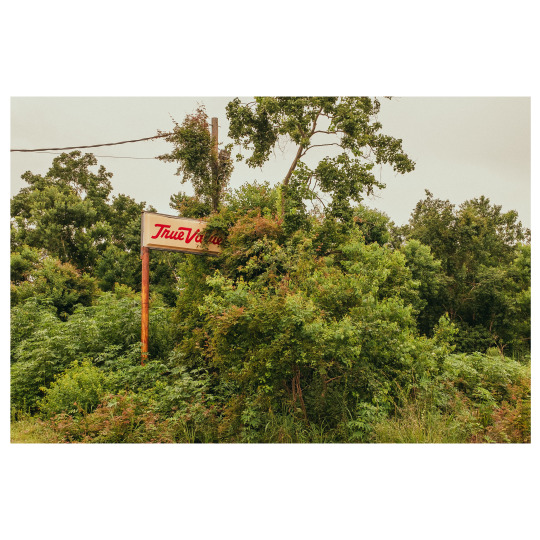
Reggio, LA 6/12 (a, b); 7/21
#photographers on tumblr#louisiana#landscape#gulf coast#landscape photography#st bernard parish#reggio#then and now
12 notes
·
View notes
Text
Transcript of the Proclamation
January 1, 1863
A Transcription
By the President of the United States of America:
A Proclamation.
Whereas, on the twenty-second day of September, in the year of our Lord one thousand eight hundred and sixty-two, a proclamation was issued by the President of the United States, containing, among other things, the following, to wit:
"That on the first day of January, in the year of our Lord one thousand eight hundred and sixty-three, all persons held as slaves within any State or designated part of a State, the people whereof shall then be in rebellion against the United States, shall be then, thenceforward, and forever free; and the Executive Government of the United States, including the military and naval authority thereof, will recognize and maintain the freedom of such persons, and will do no act or acts to repress such persons, or any of them, in any efforts they may make for their actual freedom.
"That the Executive will, on the first day of January aforesaid, by proclamation, designate the States and parts of States, if any, in which the people thereof, respectively, shall then be in rebellion against the United States; and the fact that any State, or the people thereof, shall on that day be, in good faith, represented in the Congress of the United States by members chosen thereto at elections wherein a majority of the qualified voters of such State shall have participated, shall, in the absence of strong countervailing testimony, be deemed conclusive evidence that such State, and the people thereof, are not then in rebellion against the United States."
Now, therefore I, Abraham Lincoln, President of the United States, by virtue of the power in me vested as Commander-in-Chief, of the Army and Navy of the United States in time of actual armed rebellion against the authority and government of the United States, and as a fit and necessary war measure for suppressing said rebellion, do, on this first day of January, in the year of our Lord one thousand eight hundred and sixty-three, and in accordance with my purpose so to do publicly proclaimed for the full period of one hundred days, from the day first above mentioned, order and designate as the States and parts of States wherein the people thereof respectively, are this day in rebellion against the United States, the following, to wit:
Arkansas, Texas, Louisiana, (except the Parishes of St. Bernard, Plaquemines, Jefferson, St. John, St. Charles, St. James Ascension, Assumption, Terrebonne, Lafourche, St. Mary, St. Martin, and Orleans, including the City of New Orleans) Mississippi, Alabama, Florida, Georgia, South Carolina, North Carolina, and Virginia, (except the forty-eight counties designated as West Virginia, and also the counties of Berkley, Accomac, Northampton, Elizabeth City, York, Princess Ann, and Norfolk, including the cities of Norfolk and Portsmouth[)], and which excepted parts, are for the present, left precisely as if this proclamation were not issued.
And by virtue of the power, and for the purpose aforesaid, I do order and declare that all persons held as slaves within said designated States, and parts of States, are, and henceforward shall be free; and that the Executive government of the United States, including the military and naval authorities thereof, will recognize and maintain the freedom of said persons.
And I hereby enjoin upon the people so declared to be free to abstain from all violence, unless in necessary self-defence; and I recommend to them that, in all cases when allowed, they labor faithfully for reasonable wages.
And I further declare and make known, that such persons of suitable condition, will be received into the armed service of the United States to garrison forts, positions, stations, and other places, and to man vessels of all sorts in said service.
And upon this act, sincerely believed to be an act of justice, warranted by the Constitution, upon military necessity, I invoke the considerate judgment of mankind, and the gracious favor of Almighty God.
In witness whereof, I have hereunto set my hand and caused the seal of the United States to be affixed.
Done at the City of Washington, this first day of January, in the year of our Lord one thousand eight hundred and sixty three, and of the Independence of the United States of America the eighty-seventh.
By the President: ABRAHAM LINCOLN
WILLIAM H. SEWARD, Secretary of State.
#proclamation one#freedom#freeing the slaves#lincoln#end of us slavery#almost ended slavery#war between the states#civil war#us slavery of Black People
5 notes
·
View notes
Text
On to Round 2!
This is a wrap-up of the current standings. Polls for round 2 will be published starting this Saturday (12/16).
Congratulations to all the counties that progressed!
The state that is standing the strongest is New York, with 39 counties progressing to round 2! Albany, Allegany, Allegany, Broome, Cattaraugus, Chautauqua, Chemung, Chenango, Clinton, Columbia, Delaware, Franklin, Greene, Hamilton, Jefferson, Kings, Livingston, Nassau, New York, Niagara, Oneida, Orange, Otsego, Putnam, Rensselaer, Richmond, Rockland, Saint Lawrence, Saratoga, Schuyler, Steuben, Suffolk, Sullivan, Ulster, Warren, Washington, Wayne, Westchester, and Wyoming.
Next most powerful state is Virginia, which has 36 winning counties. Alleghany, Alleghany, Amherst, Augusta, Bedford, Brunswick, Caroline, Carroll, Charlotte, Chesterfield, Fairfax, Fauquier, Fluvanna, Gloucester, Goochland, Grayson, Halifax, Isle of Wight, James City, King and Queen, King George, King William, Lee, Louisa, Montgomery, Patrick, Pittsylvania, Prince Edward, Pulaski, Rockingham, Scott, Smyth, Southampton, Tazewell, Warren, and Wise.
Ohio is also standing strong with 27 advancing counties. Brown, Butler, Columbiana, Coshocton, Crawford, Defiance, Erie, Fulton, Geauga, Holmes, Jackson, Lake, Lawrence, Licking, Madison, Mahoning, Medina, Mercer, Monroe, Muskingum, Perry, Pickaway, Ross, Scioto, Seneca, Trumbull, and Van Wert.
North Carolina is up next with a solid 24 wins. Beaufort, Cabarrus, Caldwell, Camden, Carteret, Craven, Currituck, Granville, Harnett, Henderson, Hoke, Jackson, Johnson, Lenoir, Lincoln, Macon, Madison, Mecklenburg, Northampton, Onslow, Person, Robeson, Tyrrell, and Wake.
Only 1 more state has over 20 counties that made won their match-ups and that's my wonderful Washington. Adams, Asotin, Chelan, Clallam, Cowlitz, Ferry, Garfield, Grant, Grays Harbor, King, Kitsap, Kittitas, Klickitat, Lewis, Pacific, Pend Oreille, Skagit, Snohomish, Thurston, Walla Walla, Whatcom, Whitman, Yakima. Stay strong my soldiers.
A much higher number of states are comfortably in the middle of the pack. They are as follows:
Texas: 19 counties. Bosque, Collin, Dallas, Denton, Fort Bend, Goliad, Hockley, Jones, Lipscomb, Live Oak, Llano, McMullen, Milam, Ochiltree, Orange, Panola, Parker, San Patricio, and Travis.
California: 17 counties. Amador, Calaveras, El Dorado, Imperial, Lake, Mariposa, Monterey, Orange, San Benito, San Luis Obispo, Santa Barbara, Santa Clara, Santa Cruz, Solano, Tulare, Tuolumne, and Yolo.
Pennsylvania: 16 counties. Allegheny, Blair, Butler, Carbon, Dauphin, Franklin, Greene, Jefferson, Lancaster, Lycoming, Mifflin, Montgomery, Perry, Potter, Venango, and York.
Tennessee: 15 counties. Blount, Campbell, Carter, Cumberland, Hardin, Houston, Johnson, Knox, Madison, Maury, McNairy, Obion, Union, Williamson, and Wilson.
Nebraska: 13 counties. Adams, Buffalo, Cass, Cherry, Dakota, Keith, Knox, Nuckolls, Platte, Saunders, Stanton, Thayer, and Webster.
Nevada: 13 counties. Churchill, Clark, Douglas, Esmeralda, Eureka, Lander, Lincoln, Lyon, Mineral, Pershing, Storey, Washoe, and White Pine.
Illinois: 12 counties. Cook, DeKalb, Franklin, Jasper, Kane, Marion, McDonough, McHenry, Morgan, Peoria, St Clair, and Winnebago.
Maryland: 12 counties. Anne Arundel, Calvert, Carroll, Cecil, Dorchester, Frederick, Montgomery, Prince George’s, Queen Anne’s, Talbot, Washington, and Worcester.
Michigan: 12 counties. Barry, Berrien, Clinton, Genesee, Gogebic, Kalamazoo, Lake, Oceana, Ottawa, Rocommon, Sanilac, and Wexford.
Iowa: 11 counties. Dickinson, Fayette, Hancock, Hardin, Henry, Humboldt, Jefferson, Jones, Polk, Pottawattamie, and Wright.
Louisiana: 11 parishes. Ascension, Bossier, Cameron, Catahoula, Concordia, Jefferson, Lincoln, Natchitoches, St Bernard, St James, and St Tammany.
New Jersey: 11 counties. Bergen, Cumberland, Essex, Middlesex, Morris, Passaic, Salem, Somerset, Sussex, Union, and Warren.
Kentucky: 10 counties. Boone, Boyle, Breckinridge, Daviess, Leslie, Logan, Pike, Shelby, Trimble, Woodford.
Many of these poor cute states are barely hanging on. Please wish them luck.
Florida: 8 counties. Alachua, Bay, Miami-Dade, Monroe, Okaloosa, Osceola, Palm Beach, and St Johns.
New Mexico: 8 counties. Colfax, Curry, Doña Ana, Lincoln, Mora, Otero, Roosevelt, and Socorro.
Georgia: 6 counties. Bartow, Cherokee, Floyd, Fulton, Pierce, and Rockdale.
Indiana: 6 counties. Benton, Elkhart, Jennings, Marion, Marshall, and Starke.
Minnesota: 6 counties. Aitkin, Clearwater, Hennepin, Hubbard, McLeod, and Pipestone.
Wisconsin: 6 counties. Calumet, Fond du Lac, Osaukee, Portage, Racine, and Sheboygan.
Wyoming: 6 counties. Big Horn, Converse, Lincoln, Natrona, Park, and Teton.
Missouri: 5 counties. Clay, Gentry, Greene, Newton, and St Louis.
South Carolina: 5 counties. Anderson, Calhoun, Dillon, Dorchester, and Lexington.
Utah: 5 counties. Beaver, Summit, Utah, Washington, and Wayne.
Alaska: 4 boroughs. Anchorage, Juneau, Matanuska-Susitna, and Wrangell.
Arkansas: 4 counties. Cross, Searcy, Washington, and White.
Colorado: 4 counties. Douglas, El Paso, Fremont, and La Plata.
Oklahoma: 4 counties. Bryan, Payne, Rogers, and Washington.
West Virginia: 4 counties. Fayette, Marion, Monongalia, and Roane.
Alabama: 3 counties. Bullock, Cleburne, and Mobile.
Arizona: 3 counties. Coconino, Maricopa, and Yavapai.
Maine: 3 counties. Androscoggin, Hancock, and Washington.
Idaho: 2 counties. Bannock and Bonner.
Kansas: 2 counties. Atchinson and Johnson.
Massachusetts: 2 counties. Barnstable and Berkshire.
Montana: 2 counties. Gallatin and Silver Bow.
North Dakota: 2 counties. Benson and LaMoure.
Some states only have 1 county that progressed. They are: Delaware (Kent County), Hawaii (Maui County), Mississippi (Adams County), New Hampshire (Hillsborough County), Oregon (Linn County), and South Dakota (Bennet County).
```
In addition to all the winning counties above, there will be 83 new county flags folded into round 2!!! (Because of math reasoning this had to happen) Get hyped
They are as follows:
Alexander NC, Allen OH, Alpena MI, Alpena MI, Alpine CA, Arapahoe CO, Ashe NC, Avery NC, Baldwin AL, Baltimore MD, Bell KY, Benzie MI, Bernalillo NM, Black Hawk IA, Brevard FL, Camden NJ, Campbell WY, Canyon ID, Centre PA, Charles City VA, Cheatham TN, Chester PA, Clark WA, Clarke VA, Cleveland OK, Cochise AZ, Columbus NC, Coweta GA, Darke OH, Davidson NC, Elko NV, Erie PA, Florence SC, Garrett MD, Goshen WY, Greene VA, Grundy IL, Gwinnett GA, Hidalgo TX, Highland OH, Hocking OH, Holt NE, Hot Springs WY, Howard MD, Huntingdon PA, Ingham MI, Island WA, Kankakee IL, Lackawanna PA, Lawrence PA, Leelanau MI, Lehigh PA, Leon FL, Liberty TX, Lucas OH, Madera CA, Mahaska IA, Manitowoc WI, McLennan TX, Meigs OH, Milwaukee WI, Nashville and Davidson TN, Northumberland VA, Orleans NY, Page VA, Porter IN, Sacramento CA, Salt Lake UT, San Diego CA, Sangamon IL, Sevier TN, Shelby TN, Skamania WA, Spotsylvania VA, Stafford VA, Sussex VA, Terrell TX, Trinity CA, Tulsa OK, Tuscarawas OH, Ventura CA, Wahkiakum WA, Yuma AZ
5 notes
·
View notes
Text
Is the Saltwater Intrusion a Hoax for some parishes in Louisiana ?
The saltwater intrusion is due to an ongoing drought that caused the Mississippi River to have a low flow, allowing saltwater from the Gulf of Mexico to move upstream and threaten the drinking water within communities. In preparation for the intrusion, on September 25, 2023, the Governor of Louisiana, Gov. John Bel Edwards, requested to the president for a federal emergency declaration for saltwater intrusion in the lower Mississippi region. According to the article “What is Saltwater Intrusion And How Is It Affecting Louisiana's Drink Water” in the Times-Tribune, some residents in southeastern Louisiana, Plaquemines Parish and St. Bernard have become dependent upon bottled water for cooking, drinking, and bathing. The unsafe drinking water raises many concerns for those with kidney disease, high blood pressure, people on a low-sodium diet, infants, and pregnant women(Cline,2023).
Meanwhile, in New Orleans, all conversations about the intrusion have simmered down. Initially, homeowners rushed to the nearest store, purchasing dozens of cases of water to prepare for the intrusion. Likewise, businesses were preparing for the inevitable. Businesses wondered what this meant for them and if they could remain open. The community was in panic mode. According to the article "Why the saltwater wedge climbing up the Mississippi River is a wake-up call to the region”, by PBS, the intrusion's expected arrival date to New Orleans has been slowed. The U.S. Army Corps of Engineers suggested that the intrusion would not reach far enough upriver to threaten the drinking supply for most of Orleans and Jefferson Parishes. However, we must still be vigilant and be prepared to face this problem again as it occurs about once every decade: 1988,1999,2012, and 2022 (Chavez,2023).
The saltwater intrusion is being managed; however, the information about the intrusion should have been told differently to the public to discourage panic. The unnecessary panic faced in Orleans Parish is one reason people are hesitant when it comes to trusting authorities regarding specific issues. While we were panicking in New Orleans, we could have brought water to those smaller parishes hugely impacted by the intrusion. Authorities must do better in their delivery of vital information that will not cause panic but just be informative to the community about what is going on and what could happen as they do for hurricane warnings.
2 notes
·
View notes
Text
Master of Divinity: Beyond Information
Before coming to St. Bernard’s, I was pursuing an MDiv at a charismatic evangelical university. I had recently reverted to Catholicism and was looking for an education that better matched my faith. I was catechized in the 90’s, and while I learned a lot, there were still so many gaps in the understanding of my faith. I decided to pursue a Master of Divinity at a Catholic institution, pulled up the ATS website, and started searching for fully distance, Catholic MDiv programs. That's when I found St. Bernard’s. I loved the fact that the name is the same as my home parish! I did some digging on the internet and found nothing but stellar reviews of the school. To Know more visit our blog https://www.stbernards.edu/blog/master-of-divinity
0 notes
Text
Drive-in Summertime
The Crescent and Airline were popular for drive-in summertime.
Drive-in Summertime for the movies
Two views of the Crescent Drive-in, in the 1601 block of Airline Highway, and one of the Airline Drive-in, down the street at 4000 Airline. While there was a drive-in theater in Lakeview during World War II, these theaters peaked in low-value locations in Jefferson and St. Bernard Parishes.
Before…
0 notes